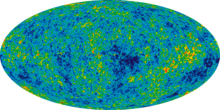
Observational cosmology

Observational cosmology is the study of the structure, the evolution and the origin of the universe through observation, using instruments such as telescopes and cosmic ray detectors. Observational cosmology is the study of the structure, the evolution and the origin of the universe through observation, using instruments such as telescopes and cosmic ray detectors. The science of physical cosmology as it is practiced today had its subject material defined in the years following the Shapley-Curtis debate when it was determined that the universe had a larger scale than the Milky Way galaxy. This was precipitated by observations that established the size and the dynamics of the cosmos that could be explained by Einstein's General Theory of Relativity. In its infancy, cosmology was a speculative science based on a very limited number of observations and characterized by a dispute between steady state theorists and promoters of Big Bang cosmology. It was not until the 1990s and beyond that the astronomical observations would be able to eliminate competing theories and drive the science to the 'Golden Age of Cosmology' which was heralded by David Schramm at a National Academy of Sciences colloquium in 1992. Distance measurements in astronomy have historically been and continue to be confounded by considerable measurement uncertainty. In particular, while stellar parallax can be used to measure the distance to nearby stars, the observational limits imposed by the difficulty in measuring the minuscule parallaxes associated with objects beyond our galaxy meant that astronomers had to look for alternative ways to measure cosmic distances. To this end, a standard candle measurement for Cepheid variables was discovered by Henrietta Swan Leavitt in 1908 which would provide Edwin Hubble with the rung on the cosmic distance ladder he would need to determine the distance to spiral nebula. Hubble used the 100-inch Hooker Telescope at Mount Wilson Observatory to identify individual stars in those galaxies, and determine the distance to the galaxies by isolating individual Cepheids. This firmly established the spiral nebula as being objects well outside the Milky Way galaxy. Determining the distance to 'island universes', as they were dubbed in the popular media, established the scale of the universe and settled the Shapley-Curtis debate once and for all. In 1927, by combining various measurements, including Hubble's distance measurements and Vesto Slipher's determinations of redshifts for these objects, Georges Lemaître was the first to estimate a constant of proportionality between galaxies' distances and what was termed their 'recessional velocities', finding a value of about 600 km/s/Mpc. He showed that this was theoretically expected in a universe model based on general relativity. Two years later, Hubble showed that the relation between the distances and velocities was a positive correlation and had a slope of about 500 km/s/Mpc. This correlation would come to be known as Hubble's law and would serve as the observational foundation for the expanding universe theories on which cosmology is still based. The publication of the observations by Slipher, Wirtz, Hubble and their colleagues and the acceptance by the theorists of their theoretical implications in light of Einstein's General theory of relativity is considered the beginning of the modern science of cosmology. Determination of the cosmic abundance of elements has a history dating back to early spectroscopic measurements of light from astronomical objects and the identification of emission and absorption lines which corresponded to particular electronic transitions in chemical elements identified on Earth. For example, the element Helium was first identified through its spectroscopic signature in the Sun before it was isolated as a gas on Earth. Computing relative abundances was achieved through corresponding spectroscopic observations to measurements of the elemental composition of meteorites. A cosmic microwave background was predicted in 1948 by George Gamow and Ralph Alpher, and by Alpher and Robert Herman as due to the hot Big Bang model. Moreover, Alpher and Herman were able to estimate the temperature, but their results were not widely discussed in the community. Their prediction was rediscovered by Robert Dicke and Yakov Zel'dovich in the early 1960s with the first published recognition of the CMB radiation as a detectable phenomenon appeared in a brief paper by Soviet astrophysicists A. G. Doroshkevich and Igor Novikov, in the spring of 1964. In 1964, David Todd Wilkinson and Peter Roll, Dicke's colleagues at Princeton University, began constructing a Dicke radiometer to measure the cosmic microwave background. In 1965, Arno Penzias and Robert Woodrow Wilson at the Crawford Hill location of Bell Telephone Laboratories in nearby Holmdel Township, New Jersey had built a Dicke radiometer that they intended to use for radio astronomy and satellite communication experiments. Their instrument had an excess 3.5 K antenna temperature which they could not account for. After receiving a telephone call from Crawford Hill, Dicke famously quipped: 'Boys, we've been scooped.' A meeting between the Princeton and Crawford Hill groups determined that the antenna temperature was indeed due to the microwave background. Penzias and Wilson received the 1978 Nobel Prize in Physics for their discovery. Today, observational cosmology continues to test the predictions of theoretical cosmology and has led to the refinement of cosmological models. For example, the observational evidence for dark matter has heavily influenced theoretical modeling of structure and galaxy formation. When trying to calibrate the Hubble diagram with accurate supernova standard candles, observational evidence for dark energy was obtained in the late 1990s. These observations have been incorporated into a six-parameter framework known as the Lambda-CDM model which explains the evolution of the universe in terms of its constituent material. This model has subsequently been verified by detailed observations of the cosmic microwave background, especially through the WMAP experiment.
